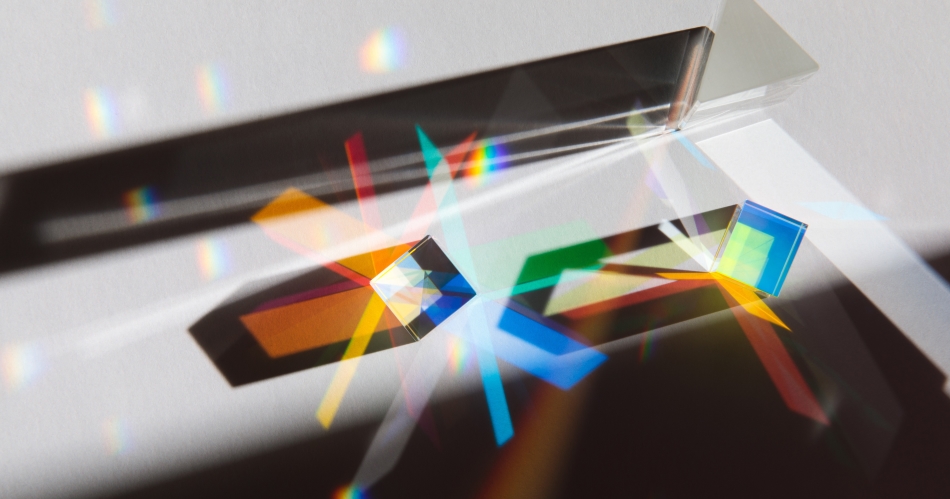Dichroic Glass and How It Works
Tips on using dichroic glass in architectural glazing applications

Dichroic glass captivates architects, designers and artists with its vibrant and ever-changing colors. It introduces a unique and dynamic element to architectural and interior designs. But what exactly is dichroic glass, how does it work and what makes it ideal for architectural glazing applications?
Dichroic glass defined
Dichroic glass creates a distinct visual impact by changing color in different lighting conditions or from various angles. This effect results from a complex process that applies multiple micro-layers of metal oxides to the glass surface. Materials like titanium, silicon or magnesium create an interference effect, causing the glass to reflect and transmit different wavelengths of light.
How dichroic glass works
The magic of dichroic glass lies in its layered structure. Thin metal-oxide layers interfere with the light wavelengths passing through or reflecting off the glass, creating the dichroic effect. As a result, the glass changes color based on the angle of view and light conditions. This dynamic visual quality makes dichroic glass an intriguing material, adding aesthetic and functional value to architectural projects.
Properties and characteristics
- Color shifting — Dichroic glass exhibits distinct colors when viewed from various angles due to the interference effects of light waves reflecting off the multiple thin layers.
- Transparency and reflection — It reflects specific colors while allowing others to pass through.
- Durability — The metal-oxide coating process enhances the durability and scratch resistance of the glass.
Manufacturing processes
Thin-film deposition: The glass is coated with multiple layers of metal oxides using techniques such as physical vapor deposition. The finished glass can have as many as 30 to 50 layers of these materials, yet the thickness of the total coating is approximately 30 to 35 millionths of an inch (about 760 to 890 nanometers).
Film applications: Dichroic film is an alternative that can be applied to existing glass surfaces or laminated to achieve similar effects. These applications are ideal for retrofitting structures to incorporate dichroic properties.
Architectural Applications
Facades and cladding
- Aesthetic appeal — Creates visually striking building exteriors with a dynamic and modern touch.
- Energy efficiency — Reflective properties reduce heat gain, contributing to the building's energy efficiency.
Windows and skylights
- Light control — Controls the amount and quality of light entering a space, enhancing natural lighting while providing ultraviolet protection.
- Artistic elements — Adds creative and decorative elements to windows and skylights.
Interior design
- Partitions, ceilings and walls — Creates visually impactful interior spaces.
- Decorative features — Utilized in furniture, countertops and decorative panels.
Art installations
- Public art — Employed in public art installations to create vibrant and interactive pieces.
- Architectural accents — Used as accents in various parts of a building to add visual interest.
Signage and branding
- Innovative signage — Enhances signage and branding elements for buildings and businesses, making them stand out.
Benefits
- Aesthetic versatility — Offers a wide range of color and design possibilities.
- Enhanced lighting — Improves natural lighting while providing UV protection.
- Energy efficiency — Reflective properties contribute to building energy efficiency.
- Durability — Resistant to scratches and environmental wear.
Market demand for dichroic glass
According to Market Research Future, “The dichroic glass market size was valued at USD 100.1 million in 2023. The dichroic glass industry is projected to grow from $109.3 million in 2024 to $234 million by 2032, exhibiting a compound annual growth rate of 9.9% during the forecast period (2024–2032). The growing usage of dichroic glass in architectural applications and technological advancements are the key market drivers boosting the expansion of the market.”
Design considerations
Due to the intricate manufacturing process, dichroic glass can be more expensive than traditional glass. While readily available through specialty glass suppliers, most glass fabricators do not typically stock dichroic glass. Because the color changes with lighting and viewing angle, it is crucial to examine a physical mock-up to assess its appearance and impact in the intended setting accurately.
Dichroic glass in architecture
Dichroic glass enhances the visual and functional aspects of architectural design. Its unique properties make it a popular choice for various applications in modern architecture. To learn more about dichroic glass and how it can enhance your architectural and interior design projects, visit generalglass.com to explore our LumiChroic dichroic glass products. You can also view our YouTube videos demonstrating how the colors change based on lighting and angle, showcasing this incredible glass solution's full potential.


